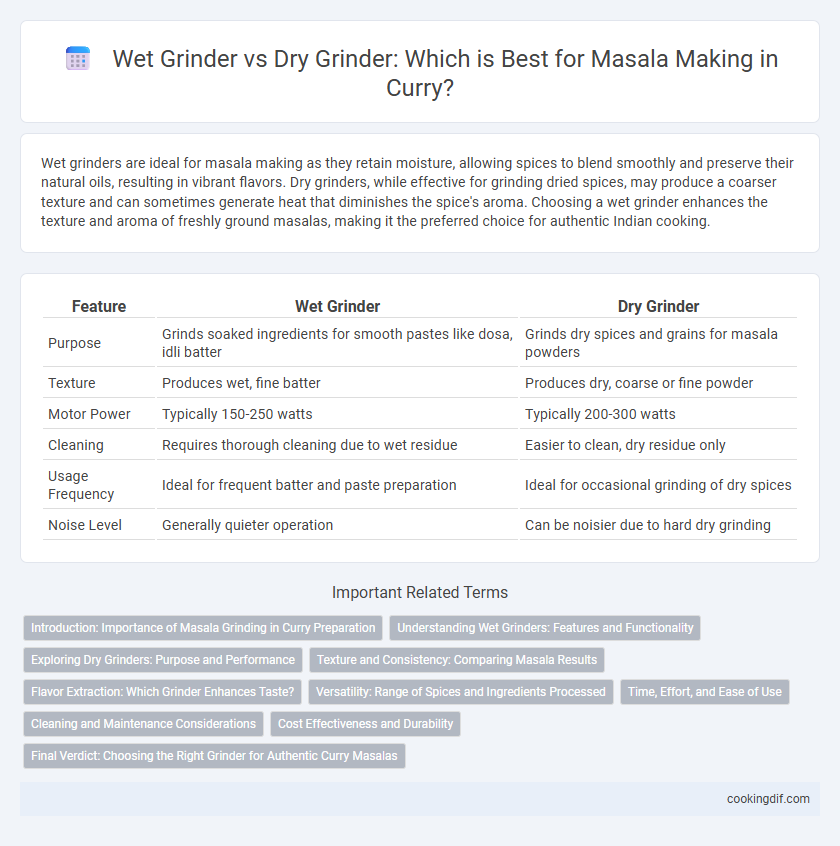Wet grinders are ideal for masala making as they retain moisture, allowing spices to blend smoothly and preserve their natural oils, resulting in vibrant flavors. Dry grinders, while effective for grinding dried spices, may produce a coarser texture and can sometimes generate heat that diminishes the spice's aroma. Choosing a wet grinder enhances the texture and aroma of freshly ground masalas, making it the preferred choice for authentic Indian cooking.
Table of Comparison
| Feature | Wet Grinder | Dry Grinder |
|---|---|---|
| Purpose | Grinds soaked ingredients for smooth pastes like dosa, idli batter | Grinds dry spices and grains for masala powders |
| Texture | Produces wet, fine batter | Produces dry, coarse or fine powder |
| Motor Power | Typically 150-250 watts | Typically 200-300 watts |
| Cleaning | Requires thorough cleaning due to wet residue | Easier to clean, dry residue only |
| Usage Frequency | Ideal for frequent batter and paste preparation | Ideal for occasional grinding of dry spices |
| Noise Level | Generally quieter operation | Can be noisier due to hard dry grinding |
Introduction: Importance of Masala Grinding in Curry Preparation
Masala grinding plays a crucial role in curry preparation by enhancing the aroma and flavor through freshly ground spices. Wet grinders retain moisture, preserving essential oils and delivering a smooth masala paste ideal for traditional curries. Dry grinders, by contrast, produce coarse, dry spice powders suitable for quick seasoning and longer shelf life.
Understanding Wet Grinders: Features and Functionality
Wet grinders for masala making utilize stone or granite grinding stones to crush spices and ingredients with water, preserving natural flavors and enhancing texture. They operate at slower speeds to prevent overheating, ensuring essential oils and aromas remain intact during the grinding process. The consistent moisture content aids in producing a smooth, fine paste essential for authentic curry flavors.
Exploring Dry Grinders: Purpose and Performance
Dry grinders are specifically designed to pulverize hard spices into fine powders, enhancing the flavor profile of masalas in Indian cooking. Their high-speed, blade-based mechanism enables efficient grinding of dry ingredients like cardamom, cinnamon, and peppercorns without moisture, preserving the essential oils and aroma. Compared to wet grinders, dry grinders offer precision in texture control, making them ideal for creating uniform, aromatic masala blends essential for authentic curry recipes.
Texture and Consistency: Comparing Masala Results
Wet grinders produce masala with a smoother texture and more consistent paste, ideal for traditional Indian curries requiring fine blending of spices and ingredients. Dry grinders yield a coarser, grainier masala, which enhances rustic curries where a crunchy texture is preferred. Choosing between wet and dry grinders depends on the desired masala consistency and the specific curry recipe's texture requirements.
Flavor Extraction: Which Grinder Enhances Taste?
Wet grinders use water during grinding, which helps release essential oils and deep flavors from spices, enhancing the masala's aroma and taste. Dry grinders operate without moisture, preserving the natural heat and sharpness of spices, resulting in a more intense and robust flavor profile. For optimal flavor extraction in masala making, wet grinders excel at blending subtle, complex flavors, while dry grinders amplify pungency and spiciness.
Versatility: Range of Spices and Ingredients Processed
Wet grinders excel in processing a wider range of spices and ingredients, including soaked lentils, soaked grains, and fresh herbs, enabling the creation of smooth pastes and batters essential for authentic masalas. Dry grinders are ideal for grinding dried spices, seeds, and nuts to fine powders, preserving the distinct aroma and flavor profiles crucial for dry masala blends. Choosing between the two depends on the variety of masala preparations, with wet grinders offering superior versatility for diverse and complex spice pastes.
Time, Effort, and Ease of Use
Wet grinders are preferred for masala making due to their ability to grind spices and ingredients into a smooth, consistent paste with less effort and in less time compared to dry grinders. Dry grinders often require repetitive grinding and more manual effort to achieve a fine powder, making them less efficient for wet masala preparations. For culinary applications involving blends with moisture, wet grinders offer superior ease of use and faster processing, ensuring enhanced flavor extraction and texture.
Cleaning and Maintenance Considerations
Wet grinders for masala making require thorough cleaning to prevent residue buildup from wet ingredients, involving disassembly and rinsing of grinding stones and drum to maintain hygiene. Dry grinders, often used for grinding dry spices, demand less frequent cleaning but require careful removal of fine powder to avoid contamination between spice batches. Regular maintenance of both types, including sharpening burrs or blades and checking motor functionality, ensures consistent grinding performance and longevity.
Cost Effectiveness and Durability
Wet grinders generally cost more upfront than dry grinders but offer superior durability due to their robust stone grinding mechanism, ideal for making smooth masala pastes. Dry grinders are more cost-effective for small-scale use and powdering dry spices but may wear out faster with regular, heavy-duty use. Choosing a wet grinder enhances long-term value in kitchens prioritizing authentic curry flavors and frequent masala preparation.
Final Verdict: Choosing the Right Grinder for Authentic Curry Masalas
Wet grinders excel at preserving the natural oils and moisture in spices, resulting in richer, aromatic masalas ideal for authentic curry flavors. Dry grinders produce a finer, dry powder that offers longer shelf life and is suitable for bulk masala preparation without altering spice texture. Choosing the right grinder depends on the desired texture and flavor intensity, with wet grinders preferred for fresh, traditional curry masalas and dry grinders favored for convenience and storage.
Wet Grinder vs Dry Grinder for masala making Infographic

 cookingdif.com
cookingdif.com